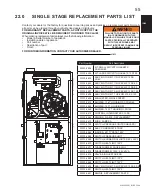
W415-1239 / A / 03.21.14
48
IOM
IOM
18.0 AIR
FLOW
18.1 TEMPERATURE RISE CHECK
H12.15.5
TABLE 1 - RANGE OF TEMPERATURE RISE
Furnace Models
Temperature Rise
ALL
35 - 65°F (20 - 36°C)
H22.0
For proper furnace operation, air
fl
ow over the heat exchanger is of utmost importance. Insuf
fi
cient air
fl
ow
accelerates metal fatigue and possible failure in the heat exchanger, as well as decrease ef
fi
ciency. Excessive
air
fl
ow promotes accelerated corrosion of the heat exchanger.
IMPORTANT:
DO NOT BYPASS THIS STEP OF THE
START UP PROCEDURES.
H22.1.1
When the duct system is complete and the air
fi
lter or
fi
lters are in place, determine if the air
fl
ow is correct.
1. Insert a duct thermometer in the supply air duct. The thermometer should be placed as close as practical
to the furnace, but out of the “line of sight” of the heat exchanger (this prevents false readings owing to
radiant heat). Ensure that the thermometer location is within the duct air stream. Avoid locations such as
the inside radius of an elbow, etc.
2. Insert a duct thermometer in the return air duct as close to the furnace as practical. Ensure that the
thermometer location will be unaffected by humidi
fi
er bypass ducts, etc. Choose a location well within the
main air stream.
3. Operate the furnace long enough to obtain steady state conditions at the input listed on the furnace rating plate.
4. When the two thermometers have stabilized, usually within 5-8 minutes, compare the two readings.
Subtract the return air temperature from the supply air temperature. The difference is the temperature rise,
also called
∆
T.
5. Compare the measured
∆
T to the temperature rise range shown on the rating plate.
Unless stated differently on the rating
plate, the temperature rise should
normally range between 35° to
65°F (20° to 36°C). When adjusting
the temperature rise, the ideal
temperature rise is approximately
50°F (28°C).
If the measured
∆
T is above the
approved temperature range,
there is too little air
fl
ow. It must be
increased by removing restrictions
in the ductwork, adding supply or
return ductwork, or by selecting a
higher motor speed.
If the measured
∆
T is too low, there
is too much air
fl
ow.
TABLE 7 - AIR FLOW (ECM X13)
X13
ESP 0.1” to 1.0” w.c.
Input
Max A/C
TAP
CFM
Tonnage
NUMBER
30000/
40000
2½ TON
5
940
4
750
3
560
2*
N/A
60000
3 TON
5
1125
4
940
3
750
2*
560
80000
3 TON
5
1125
4
940
3
750
2*
560
4 TON
5
1500
4
1125
3
750
2*
700
100000
5 TON
5
1750
4
1400
3
1050
2*
700
120000
5 TON
5
1750
4
1400
3
1050
2*
700
NOTE
Air
fl
ow based on approxi-
mately 375 CFM/Ton.
* Tap number 2 is Continuous Fan
H12.1.6A
Содержание 9500-B Series
Страница 27: ...W415 1239 A 03 21 14 27 IOM FIGURE 14A DIRECT VENT TERMINAL CLEARANCES...
Страница 28: ...W415 1239 A 03 21 14 28 IOM IOM FIGURE 14B NON DIRECT VENT TERMINAL CLEARANCES...
Страница 57: ...W415 1239 A 03 21 14 57 IOM 23 0 SERVICE HISTORY 43 1...
Страница 58: ...W415 1239 A 03 21 14 58 IOM IOM 24 0 NOTES 44 1...
Страница 74: ...6 0 NOTES 44 1 W415 1239 A 03 21 14 UM 74...
Страница 75: ...44 1 W415 1239 A 03 21 14 UM 75...
















































